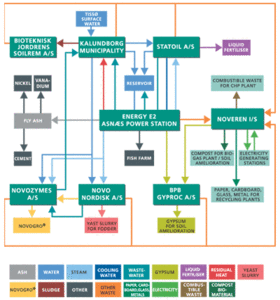Kalundborg, Denmark
Kalundborg, Denmark ( 55°40'50.20"N, 11° 5'59.75"E), a small harbor town dating back to the 12th century, is now known as the world's most prominent example of industrial symbiosis. The term refers to a community of businesses located together on a common property that seek enhanced environmental, economic, and social performance through collaboration in managing environmental and resource issues.
Kalundborg is located off the west coast of the Zealand Island in Denmark about 75 miles west of Copenhagen, and as of 2005 it had a population of approximately 20,000.
The establishment of industrial symbiosis in Kalundborg was a slow, evolutionary process. It began in 1961 with a water management project. This region of Denmark lacks an adequate supply of fresh water, so instead of using precious groundwater resources for a newly-built refinery, the city of Kalundborg constructed a pipeline to extract surface water from Lake Tissø. The Statoil oil refinery financed the project. The initial collaboration between the city and business encouraged additional collaborative efforts. The success of Kalundborg is due to six key partners who are responsible for sustaining this symbiotic relationship. The partners include:
- Asnæs power station, the largest coal-fired plant producing electricity in Denmark with a capacity of 1,500 MW.
- Statoil, an oil refinery belonging to the Norwegian State oil company.
- Novo Nordisk A/S is an international, biotechnological and pharmaceutical company. In 2000, the enzyme business of Novo Nordisk was spun off as a separate company, Novozymes A/S and is the world's leading producer of enzymes.
- Gyproc, a Swedish company that is the world leader in plasterboard and gypsum plasters among other building materials.
- Bioteknisk Jordrens SOILREM, a company that remediates and recycles soil that has been contaminated by fuels, organic solvents and heavy metals.
- The town of Kalundborg, which supplies district heating to the 20,000 residents, as well as water to the homes and industries.
Over the last two decades, these partners spontaneously developed a series of bilateral exchanges that also include a number of other companies. There was no initial planning of the overall network; it just evolved as a collection of one-to-one deals that made economic sense for participants on all sides. The symbiosis started when Gyproc located its facility in Kalundborg to take advantage of the fuel gas available from Statoil.
The energy and material partnerships include the following:
The Statoil oil refinery agreed to provide excess gas to Gyproc, which had seen Statoil's flares and recognized that this burning gas was a potential low-cost fuel source.
The Asnæs power plant began to supply the city with steam for its new district heating system in 1981, and then added Novo Nordisk and Statoil as customers for steam. The district heating, encouraged by the city and Danish government, replaced about 3,500 oil furnaces (a significant non-point source of air pollution).
The Asnæs power plant uses salt water, from the fjord, for some of its cooling needs. By doing so, it reduces the withdrawals of fresh water from Lake Tissø. The resulting by-product is hot salt water, a small portion of which is supplied to the fish farm's 57 ponds.
In 1992, the power plant began substituting fuels, using surplus refinery gas in place of some coal. This only became possible after Statoil built a sulfur recovery unit to comply with regulations on sulfur emission; the gas was then clean enough to permit use at the power plant.
The Statoil oil refinery supplies its purified wastewater as well as its used cooling water to Asnæs power station, thereby reducing freshwater withdrawl by 1 million cubic meters of water per year.
The Asnæs power plant employs cogeneration technology by supplying what would otherwise be waste steam both to heat to the Statoil refinery steam for heating processes, to Nova Nordisk steam for heating and sterilization, and to residential homes for space heating.
Nova Nordisk sells its biomass, a waste product from industrial processes mainly consisting of nitrogen, phosphorous, and potassium, to local farmers as a fertilizer.
The principal messages fron the Kalundborg experience are that all contracts have been negotiated on a bilateral basis. Each party must view a contract as economically attractive, opportunities not within a company's core business, no matter how environmentally attractive, will not be pursued, and each company evaluates their own deals independently – there is no system-wide evaluation of performance.
Further Reading
- Case studies - Kalundborg
- Industrial Symbiosis
- H. Grann, The Industrial Symbiosis at Kalundborg, Denmark, in The Industrial Green Game, D.J. Richards (ed.), National Academy Press, Washington, 1997.
- Ehrenfeld, J. R. and N. Gertler. 1997. Industrial ecology in practice: The evolution of interdependence at Kalundborg. Journal of Industrial Ecology 1(1): 67-79.
- Jacobsen, N. B. 2006. Industrial symbiosis in Kalundborg, Denmark: A quantitative assessment of economic and environmental aspects. Journal of Industrial Ecology 10(1-2): 239-255.
- Chertow, M. R. 2000. Industrial symbiosis: Literature and taxonomy. Annual Review of Energy & Environment 25(1): 313-337.
- Ehrenfeld, J. and M. R. Chertow. 2002. Industrial ecology: The legacy of Kalundborg. In Handbook of Industrial Ecology, edited by R. Ayres and L. Ayres. Cheltanham, UK: Edward Elgar Publishing, Inc.
